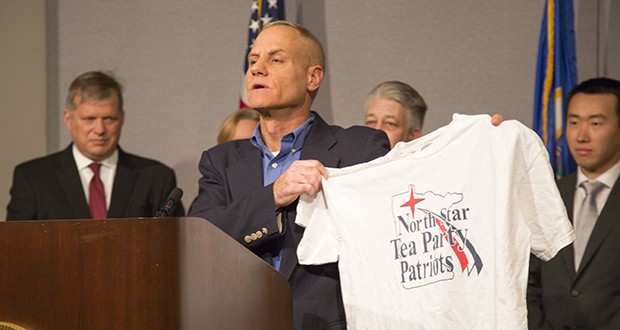What’s in a Shirt? Supreme Court Declares Political Attire Harmless at the Voting Booth

By David Patou
It is not at the top of everyone’s radar screen, given other major decisions and the retirement of a key justice, but toward the end of its recent session, the Supreme Court overturned a Minnesota law that barred the wearing of politically expressive clothing at polling places on Election Day. The case has far-reaching, if thus far little-noticed, implications for Free Speech in the United States.
During February’s oral arguments in Minnesota Voters Alliance v. Mansky, the nonprofit Minnesota Voters Alliance (MVA) argued that any restriction on the commonplace and easily affordable political speech represented by the wearing of partisan or issue-oriented T-shirts and the like is an overly broad, and therefore unconstitutional, constraint under the First Amendment.
The Minnesota government, represented by Joe Mansky, election manager for Ramsey County, and other election officials across the state, maintained that the law was a reasonable and proper effort to protect citizens’ right to vote in an undisturbed manner — particularly important in the fight to prevent certain communities of voters from being intimidated. In a 7–2 ruling against Mansky, the court reinforced the precedent that passive speech (in this case the wearing of clothing or paraphernalia with messages) differs from active forms of speech.
In Burson v. Freeman (1992), the Supreme Court had affirmed the constitutionality of laws that prevent active campaigning at the polling place. This case, then, clarifies that passive expression cannot be restricted in the ways that more active speech can be. Had the court upheld the law, it would have granted broad interpretive powers for the government to decide which types of passive speech are political, and hence prohibited, and which are not — a power the MVA and its supporters argued was too prone to abuse. The Minnesota statute at issue — and similar ones in nine other states — did not define the word “political.” Instead, these laws left interpretation of what constitutes “politically expressive apparel” to election officials.
Under the law, Minnesota officials had the power to obstruct the voting process by asking individuals to remove or cover up the offending clothing and by citing them for later punishment if they did not comply.
Reported incidents of abuse of such official discretion across the country have been legion, and sometimes laughable: People have been prohibited from voting, for example, for wearing “Alaska” shirts, which were deemed supportive of Sarah Palin, the former governor of that state who was the Republican candidate for vice president in 2008. Similarly, those wearing shirts that said “MIT,” the shorthand name of the Massachusetts Institute of Technology, were accused of expressing support for Mitt Romney, the Republican presidential candidate in 2012.
As Justice Samuel Alito pointed out during oral argument on this case, shirts that read “Parkland Strong” (a reference to the high school in Florida where survivors of a shooting launched a national student movement to promote gun control), “National Rifle Association,” or even ones that present the text of the Second Amendment could be regarded as political, depending on the eagerness and the political views of the enforcer.
A potential chilling effect on voting would have been a second and equally harmful consequence if the court had sustained the Minnesota law. Voter participation rates in the United States are already relatively low, compared to those of other democracies. If protecting the integrity of the polling place were done in a manner that dissuades people from coming to the polls altogether, it could be self-defeating.
Opponents of the statute argued that if it were upheld, voters might have to plan their outfits delicately before leaving home on Election Day. In a climate of strict enforcement, should someone forget and accidentally wear a “tree-hugger” shirt, he or she might decide to forgo voting altogether.
Writing the majority opinion for the court, Chief Justice John Roberts left open the possibility that a similar law with more specific and narrow jurisdiction could be permissible, due to the substantial state interest in protecting the integrity of the polling place.
Still, Justices Sonia Sotomayor and Stephen Breyer, the two dissenting votes, found reason for concern in a context of no regulation. Shirts that say “Please ID Me” (as was the case with members of the MVA) or have hateful messages do in fact disrupt the sanctity of the polling place, they contended, and states have good reason to prevent such disruptions. Many argue that efforts to dissuade voters — particularly minority voters from poorer communities who frequently do not have ID cards — do serious damage to U.S. democracy.
States should continue to find ways to encourage voting across all communities and to fight voter intimidation. Yet the Minnesota statute in question was overly broad in addressing that interest and as such prohibited harmless and protected speech. As the effects of the ruling become more apparent in coming elections, states may well take advantage of the opportunity to create moderate restrictions that both protect the sanctity of the election process and preserve a broad definition of Free Speech.
David Patou graduated in 2018 from Georgetown University with a major in philosophy and minors in economics and Jewish civilization. He will be working for Bain & Company in New York City, beginning in the fall.